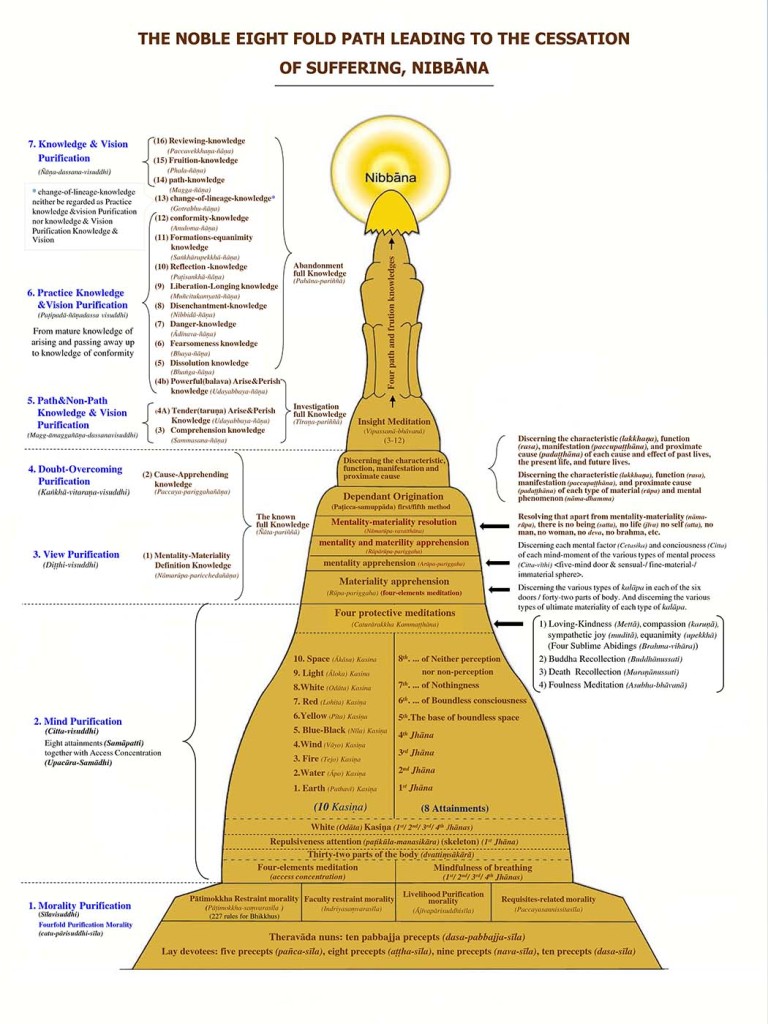What is taught and practised in Pa-Auk

The Noble Eight Fold Path Leading to The Cessation of Suffering, Nibbāna
导至苦之灭尽——涅槃的八圣道
The system of meditation taught at Pa-Auk Tawya is based on the instructions by The Buddha as found in the Tipiṭaka (the Pāli Canon) and its commentaries. The system comprises the threefold training of strict observance of precepts (sīla), developing concentration(samādhi), as a basis for attaining wisdom (paññā). This is further subdivided into the seven stages of purification which provide a step-by-step formula for systematically purifying one’s body (physical actions), speech and mind of defilements in order to realize Nibbāna in this lifetime.
Teachings:
- Mindfulness-of-Breathing (ānāpānassati) – to develop absorption concentration (the four jhānas)
- Most of the forty Samatha subjects taught by The Buddha – including loving-kindness (mettā) meditation, the thirty-two parts of the body, the ten kasinas and the four immaterial jhānas
- Four-Elements Meditation – to analyze ultimate materiality and ultimate mentality
- Dependent Origination – to discern past, present and future lives by analysing their causes and conditions
- Vipassanā Meditation – to discern the five aggregates (materiality and mentality) as impermanent, subject to suffering and without a self
In brief, the main practice is to begin with Samatha meditation, which is to develop absorption concentration, also called jhāna. A meditator is free to choose any of the forty Samatha subjects as taught by the Buddha. In Pa-Auk Tawya, most meditators develop jhāna with mindfulness-of-breathing (ānāpānassati). Having developed Samatha, the meditator may proceed to practise Vipassanā meditation.
As an alternative, the meditator may omit the development of jhāna. He/she (“he”) will be taught instead to develop the less powerful access concentration with the Samatha subject of Four-Element meditation, prior to the practice of Vipassanā meditation. In either case, the concentration attained by the meditator produces the ‘light of wisdom’.
Having completed the development of his/her (“his”) Samatha meditation, the meditator is then taught to protect his practice with the Four Protective Meditations of Mettā (Loving Kindness), Buddhānussati (Recollection of The Buddha), Asubha (Repulsiveness of the Body), and Maranānussati(Recollection of Death).
Following that, the meditator will be taught to prepare the way for Vipassanā meditation, which is to use the ‘light of wisdom’ to discern ultimate materiality and mentality. The meditator will also be taught to discern the workings of Dependent Origination (paṭṭiccasamuppāda). This means he will discern a number of past and future lives, and to discern the causes for certain rebirths.
Only upon having discerned ultimate materiality and mentality and their causes (Dependent Origination), does the meditator have the necessary objects for Vipassanā meditation. The practice of Vipassanā meditation is to discern the three characteristics of impermanence (anicca), suffering (dukkha), and non-self (anatta) in ultimate materiality and mentality – of past, present, and future, internal and external, gross and subtle, inferior and superior, far and near.
In accordance with the Visuddhimagga (Path of Purification), the meditator will be taught a series of detailed practices by which to develop and strengthen his Vipassanā knowledge of materiality and mentality of past, present and future. In this way, the meditator may progress through the different insight knowledges, preliminary to the attainment of Nibbāna.
Should the meditator attain Nibbāna, he will be taught how to discern which defilements have been destroyed, and which stage of enlightenment he has reached. With continued practice, the meditator may destroy all the taints, and be able to attain Arahantship, meaning he will have put a complete end to rebirth and suffering.
For further details of the teaching of meditation, please refer to the book Knowing and Seeing (5th Revision) by the Venerable Pa-Auk Tawya Sayadaw.

